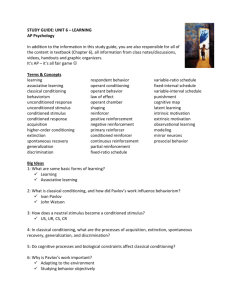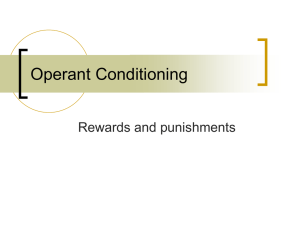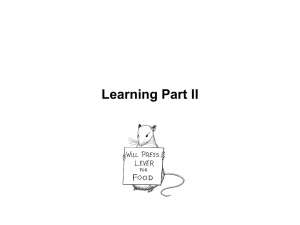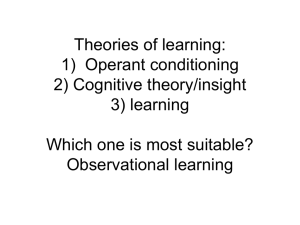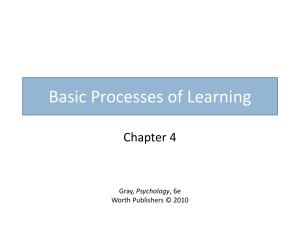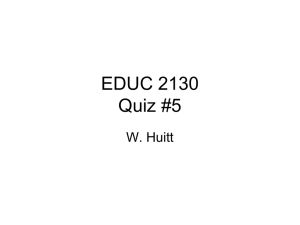12/7/15: Final Exam Review Worksheet
advertisement
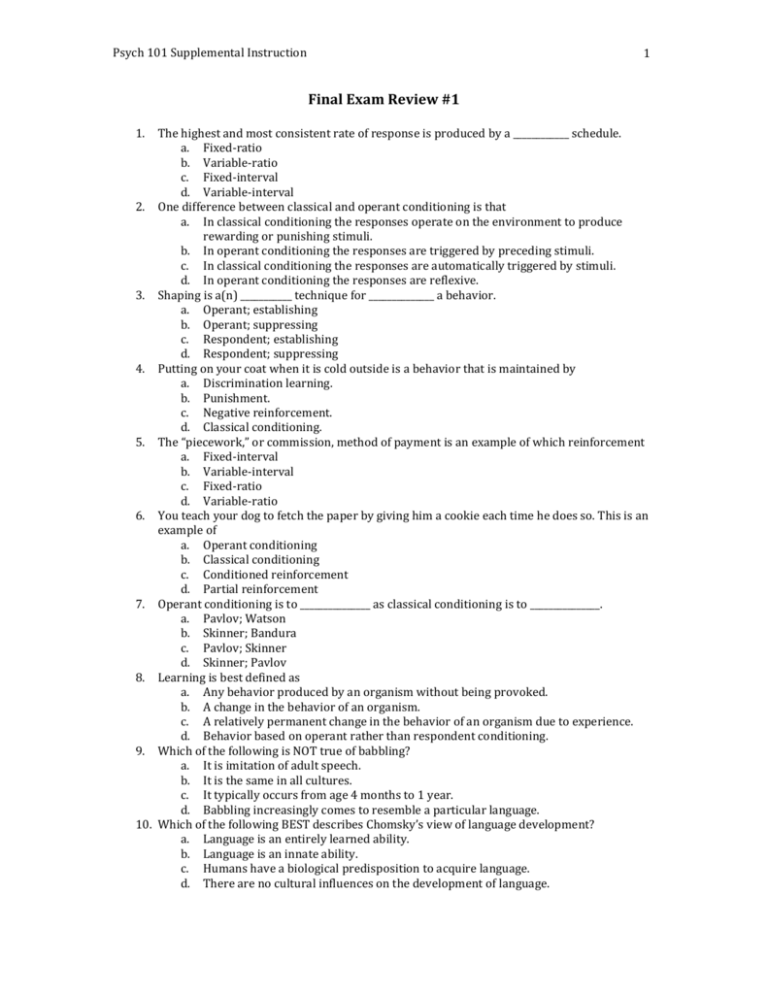
Psych 101 Supplemental Instruction 1 Final Exam Review #1 1. The highest and most consistent rate of response is produced by a ____________ schedule. a. Fixed-ratio b. Variable-ratio c. Fixed-interval d. Variable-interval 2. One difference between classical and operant conditioning is that a. In classical conditioning the responses operate on the environment to produce rewarding or punishing stimuli. b. In operant conditioning the responses are triggered by preceding stimuli. c. In classical conditioning the responses are automatically triggered by stimuli. d. In operant conditioning the responses are reflexive. 3. Shaping is a(n) ___________ technique for ______________ a behavior. a. Operant; establishing b. Operant; suppressing c. Respondent; establishing d. Respondent; suppressing 4. Putting on your coat when it is cold outside is a behavior that is maintained by a. Discrimination learning. b. Punishment. c. Negative reinforcement. d. Classical conditioning. 5. The “piecework,” or commission, method of payment is an example of which reinforcement a. Fixed-interval b. Variable-interval c. Fixed-ratio d. Variable-ratio 6. You teach your dog to fetch the paper by giving him a cookie each time he does so. This is an example of a. Operant conditioning b. Classical conditioning c. Conditioned reinforcement d. Partial reinforcement 7. Operant conditioning is to _______________ as classical conditioning is to _______________. a. Pavlov; Watson b. Skinner; Bandura c. Pavlov; Skinner d. Skinner; Pavlov 8. Learning is best defined as a. Any behavior produced by an organism without being provoked. b. A change in the behavior of an organism. c. A relatively permanent change in the behavior of an organism due to experience. d. Behavior based on operant rather than respondent conditioning. 9. Which of the following is NOT true of babbling? a. It is imitation of adult speech. b. It is the same in all cultures. c. It typically occurs from age 4 months to 1 year. d. Babbling increasingly comes to resemble a particular language. 10. Which of the following BEST describes Chomsky’s view of language development? a. Language is an entirely learned ability. b. Language is an innate ability. c. Humans have a biological predisposition to acquire language. d. There are no cultural influences on the development of language. Psych 101 Supplemental Instruction 2 11. Damage to __________ will usually cause a person to lose the ability to comprehend language. a. Any area of the brain b. Broca’s area c. Wenicke’s area d. Frontal lobe association areas 12. Telegraphic speech is typical of the __________ stage. a. Babbling b. One-word c. Two-word d. Three-word 13. Phonemes are the basic units of _________ in language. a. Sound b. Meaning c. Grammar d. Semantics 14. Of the following, the best way to separate the effects of genes and environment in research is to study a. Fraternal twins. b. Identical twins. c. Adopted children and their adoptive parents. d. Identical twins raised in different environments. 15. According to evolutionary psychology, men are drawn sexually to women who seem ___________, while women are attracted to men who seem ____________. a. Nurturing; youthful b. Youthful and fertile; mature and affluent c. Slender; muscular d. Exciting; dominant 16. Unlike __________ twins, who develop from a single fertilized egg, __________ twins develop from separate fertilized eggs. a. Fraternal; identical b. Identical; fraternal c. Placental; nonplacental d. Nonplacental; placental 17. Temperament refers to a person’s characteristic a. Emotional reactivity and intensity. b. Attitudes. c. Behaviors. d. Role-related traits. 18. Mutations are random errors in _______ replication. a. Gene b. Chromosome c. DNA d. Protein 19. The fertilized egg will develop into a boy if, at conception, a. A sperm contributes an X chromosome. b. A sperm contributes a Y chromosome. c. The egg contributes an X chromosome. d. The egg contributes a Y chromosome. 20. Providing a child with stimulating educational environment during early childhood is likely to a. Ensure the formation of a strong attachment with parents. b. Foster the development of a calm, easygoing temperament. c. Prevent neural connections from degenerating. d. Do all of these things. Psych 101 Supplemental Instruction 3 21. In Piaget’s stage of concrete operational intelligence, the child acquires an understanding of the principle of a. Conservation b. Deduction c. Attachment d. Object permanence 22. Piaget held that egocentrism is characteristic of the a. Sensorimotor stage. b. Preoperational stage. c. Concrete operational stage. d. Formal operational stage. 23. During which stage of cognitive development do children acquire object permanence? a. Sensorimotor. b. Preoperational. c. Concrete operational. d. Formal operational. 24. Stranger anxiety develops soon after a. The concept of conservation. b. Egocentrism. c. A theory of mind. d. The concept of object permanence. 25. Insecurely attached infants who are left by their mothers in an unfamiliar setting often will a. Hold fast to their mothers on their return. b. Explore the new surroundings confidently. c. Be indifferent toward their mothers on their return. d. Display little emotion at any time. 26. The term critical period refers to a. Prenatal development. b. The initial 2 hours after a child’s birth. c. The preoperational stage. d. A restricted time for learning. 27. According to Erikson, the central psychological challenges pertaining to adolescence, young adulthood, and middle age, respectively, are a. Identity formation; intimacy; generativity. b. Intimacy, identity formation; generativity. c. Generativity; intimacy; identity formation. d. Intimacy; generativity; identity formation. 28. In preconventional morality, the person a. Obeys out of a sense of social duty. b. Conforms to gain social approval. c. Obeys to avoid punishment or to gain concrete rewards. d. Follows the dictates of his or her conscience. 29. According to Piaget, the ability to think logically about abstract propositions is indicative of the stage of a. Preoperational thought. b. Concrete operations. c. Formal operations. d. Postconventional thought. 30. Adolescence is marked by the onset of a. An identity crisis. b. Parent-child conflict. c. The concrete operational stage. d. Puberty. 31. Most researchers agree that a. Media violence is a factor in aggression. Psych 101 Supplemental Instruction b. c. 32. 33. 34. 35. 36. 37. 38. 39. 40. 41. 4 There is a negative correlation between media violence and aggressiveness. Paradoxically, watching excessive pornography ultimately diminishes an individual’s aggressive tendencies. d. Media violence is too unreal to promote aggression in viewers. Aggression is defined as behavior that a. Hurts another person. b. Is intended to hurt another person. c. Is hostile, passionate, and produces physical injury. d. Has all of these characteristics. Which of the following is true about aggression? a. It varies too much to be instinctive in humans. b. It is just one instinct among many. c. It is instinctive but shaped by learning. d. It is the most important human instinct. Which is the correct sequence of stages in Piaget’s theory of cognitive development? a. Sensorimotor, peroperational, concrete operational, formal operational b. Sensorimotor, preoperational, formal operational, concrete operational c. Preoperational, sensorimotor, formal operational, concrete operational d. Preoperational, sensorimotor, concrete operational, formal operational To which of Kohlberg’s levels would moral reasoning based on the existence of fundamental human rights pertain? a. Preconvetional morality b. Conventional morality c. Postconventional morality d. Generative morality In Erikson’s theory, individuals generally focus on developing __________ during adolescence and then ____________ during young adulthood. a. Identity; intimacy b. Intimacy; identity c. Basic trust; identity d. Identity; basic trust Whose stage theory of moral development was based on how people reasoned about ethical dilemmas? a. Erikson b. Piaget c. Harlow d. Kohlberg Syntax refers to the a. Sounds in a word. b. Rules for ordering words into sentences. c. Rules by which meaning is derived from sentences. d. Overall rules of a language. Our ability to learn a new language a. Diminishes with age. b. Is limited by a sharply defined critical period. c. Remains constant throughout our lives. d. Depends on the language. For operant conditioning to be most effective, when should the reinforcers be presented in relation to the desired response? a. Immediately before b. Immediately after c. At the same time as d. At least a half-hour before Which of the following is the best example of a conditioned reinforcer? a. Putting on a coat on a cold day Psych 101 Supplemental Instruction 42. 43. 44. 45. 46. 47. 48. 49. 50. 5 b. Relief from pain after the dentist stops drilling your teeth c. Receiving a cool drink after washing your mother’s car on a hot day d. Receiving an approving nod from the boss for a job well done. A response that leads to the removal of an unpleasant stimulus is one being a. Positively reinforced b. Negatively reinforced c. Punished d. Extinguished Reggie’s mother tells him that he can watch TV after he cleans his room. Evidently, Reggie’s mother is attempting to use _______________ to increase room cleaning. a. Operant conditioning b. Secondary reinforcement c. Positive reinforcement d. All of these procedures In promoting observational learning, the most effective models are those that we perceive as a. Similar to ourselves. b. Respected and admired. c. Successful. d. Having any of these characteristics. Learning by imitating others’ behaviors is called __________ learning. The researchers best known for studying this type of learning is _____________. a. Secondary; Skinner b. Observational; Bandura c. Secondary; Pavlov d. Observational; Watson Violent criminals often have diminished activity in the ____________ of the brain, which play(s) an important role in ____________. a. Occipital lobes; aggression b. Hypothalamus; hostility c. Frontal lobes; controlling impulses d. Temporal lobes; patience Punishment is a controversial way of controlling behavior because a. Behavior is not forgotten and may return. b. Punishing stimuli often create fear. c. Punishment often increases aggressiveness. d. Of all of these reasons. Which of the following is an example of a reinforcement? a. Presenting a positive stimulus after a response b. Removing an unpleasant stimulus after a response c. Being told that you have done a good job d. All of these are examples Children first demonstrate a rudimentary understanding of syntax during the __________ stage. a. Babbling b. One-word c. Two-word d. Three-word Which of the following is cited by Chomsky as evidence that humans are born with a predisposition to learn language? a. Children master the complicated rules of grammar with ease. b. Different languages do not have the same grammatical building blocks. c. Children make unpredictable mistakes as they acquire grammar. d. Children raised in isolation from language spontaneously begin speaking words.
